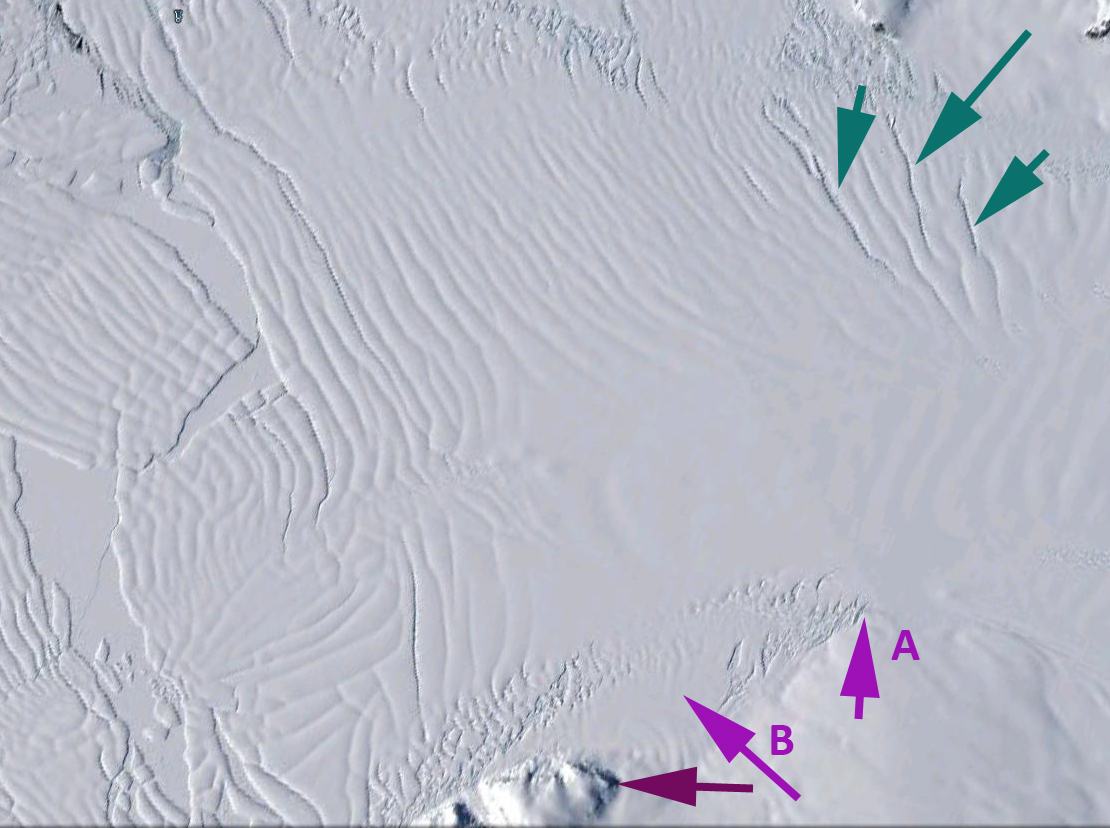April 26, 2012
Smith Glacier Thining, Rifting, Retreat, Antarctica
Posted by Mauri Pelto
Smith Glacier, West Antarctica is two glaciers to the west of Pine Island Glacier flowing into the Crosson Ice Shelf in the Amundsen Sea. Pine Island Glacier (PIG) has been the focus of more extensive study because of its size and its identification as the weak underbelly of the West Antarctic Ice Sheet. Two recent papers have focused on changes on glaciers in the region. Pritchard et al (2009) identified thinning over almost all of Smith Glacier, thinning near the grounding line and on the floating ice shelf has been 9 m/year from 2003-2007, somewhat more than PIG, top image. Smith Glaciers floating section the Crosson ice Shelf northwestern margin is buttressed by the Bear Peninsula. Since 1984 MacGregor et al, (2012) identified increased rifting and detachment from the peninsula. The peninsula has been a pinning point, detachment can lead to destabilization of the ice shelf. They further identified a 24 km retreat of the terminus since 1990 and a reduced area of attachment and increased rifting near Mount Murphy. The terminus position change is seen in the second image below. The light blue color is 1984 and the red colors are the 2007 and 2011 terminus position, In this post we look at the detachment from the Bear Peninsula.
 Like on PIG Smith Glacier has accelerated by 500 m/year, nearly doubling its velocity. The loss of buttressing and reduced size of the ice shelf reduces back forces that would allow acceleration. Point A marks the location where attachment is in 2011, Point B marks an area of attachment between the Crosson ice Shelf and the Bear Peninsula in 1999 (top image below) and 2002 (second image). By 2011 (bottom two images) this area around B is not attached and also has expanded rifting.
Like on PIG Smith Glacier has accelerated by 500 m/year, nearly doubling its velocity. The loss of buttressing and reduced size of the ice shelf reduces back forces that would allow acceleration. Point A marks the location where attachment is in 2011, Point B marks an area of attachment between the Crosson ice Shelf and the Bear Peninsula in 1999 (top image below) and 2002 (second image). By 2011 (bottom two images) this area around B is not attached and also has expanded rifting.



The entire Crosson Ice Shelf is threatened by rifting near Mount Murphy (blue arrows above and green arrows below) that were noted by MacGregror et al (2012). The rifting has expanded in number and extent from 2011 above to 1999 below. The entire ice shelf with acceleration shows considerable rifting, which combined with thinning has been a recipe for destabilization and breakup of ice shelves on the Antarctic Peninsula, such as at Wilkins Glacier, Fleming Glacier and Prospect Glacier. The thinning has been noted as widespread around most of Anarctic Ice Shelves in a paper this week from Pritchard et al (2012). This paper from an international team from British Antarctic Survey, Utrecht University, Scripps Institution of Oceanography and Earth & Space Research has identified the losses are principally the result of increased basal melting from intrusion at depth of warm water. In the Smith Glacier area there is no significant surface melting, so basal melting must be the source. 


 Dean of Academic Affairs at Nichols College and Professor of Environmental Science at Nichols College in Massachusetts since 1989. Glaciologist directing the North Cascade Glacier Climate Project since 1984. This project monitors the mass balance and behavior of more glaciers than any other in North America.
Dean of Academic Affairs at Nichols College and Professor of Environmental Science at Nichols College in Massachusetts since 1989. Glaciologist directing the North Cascade Glacier Climate Project since 1984. This project monitors the mass balance and behavior of more glaciers than any other in North America.
[…] the West Antarctic Ice Sheet interior. For example Prof Mauri Pelto wrote a great blog post about the retreat of the Smith Glacier which feeds the Dotson Ice Shelf. It is also an area where a while ago I wrote in Recent Amundsen […]